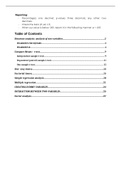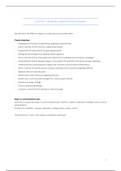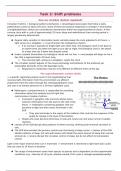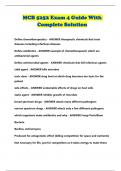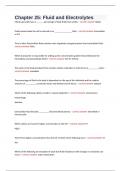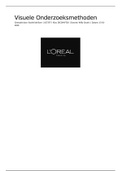Applied Economics Revision
Topic 1: Return to Education
● Around the 1960s, Economists started trying to understand why some individuals
pursue post-compulsory education and others not
● Traditionally we studied how/why agents invest in capital
● Education is the earliest investment an individual will make
● What is the return to this investment: for every extra year of schooling what is the
gain to human capital
● There is overwhelming evidence of a positive correlation between earnings and
education. (Krueger, 2001)
Which economic theories predict a return to education?
● Human capital theory: education is useful. School/College/University teaches you
skills which employers value and you use in the workplace. (Gary Becker, 1964 -
Nobel prize, 1992)
● Signalling theory: educational qualifications serve only to signal your type. (In the
jargon it is a solution to the problem of adverse selection.) The job market then infers
your suitability from academic qualifications.
○ Nothing inherently useful about education per se (in itself). E.g. speaking
latin. (Spence, 1973- Nobel prize, 2001) i.e.: Your CV does not truly reflect
how productive you are.
Asymmetric information
➔ Productivity of an individual is hidden
➔ High productivity (P_H)
◆ Signal that you are P_H by schooling
● More costly for low productivity (P_L)
Empirical Application: The Mincer Earnings Regression
The Human Capital Earnings Function (HCEF) or ‘Mincer regression’ (Mincer, 1974):
(1)
Where y is earnings, S is level of schooling, X is years experience (without X^2 it would
determine a linear relationship which is not true), u is the residual (everything not included in
variables that determines wage) and α, β, γ (>0 as X increases, earnings increase) and δ
(<0 as the rate of increase slows across X) are parameters to be estimated in regression
analysis. (Data: log(y), S and X: observable.) Some econometric issues. (1) Assumes
quadratic form in X (arguably a reasonable approximation. Assumes linear returns to
Schooling (S) measurement of S and y. Interpretation of 𝛃: correlation between s and y, an
increase in S by 1 leads to an increase in log(y) by 𝛃.
, Measurement of Education
An increase in X from 0 means log(y) would increase by delta, increasing at a decreasing
rate.
● S typically measured as #years Schooling
● But are all years the same?
● Productivity of year of Primary Education = Productivity of year of Tertiary Education
● Productivity of a NYU degree = Productivity of a York degree = Productivity of a York
St. John degree?
● Nonlinearities: marginal effect of your final year (if successful) much greater than the
marginal effect of your first year.
Card (1999)’s data implies that the linearity assumption may be reasonable as an
approximation.
● Annual earnings = Hourly earnings * Hours/week * weeks worked.
● Greater education levels imply higher hourly wages and longer working hours
● Note that earnings measures (especially hourly earnings) are log-normally-distributed
The basic mincer equation explains 20-35% of the variation in observed earnings data, with
estimated coefficients close to expected values.
Causal effects vs correlations
Schooling >>> Beta >>> Earnings
Causal
Effect
(Policy)
Beta = by how much earnings will increase with S.
● A causal effect of S on y is the direct effect of S on y
● It tells us, if S was randomly increased by 1 unit, what will be the direct effect on y
● This is the policy parameter
The basic Mincer equation: identification problem
Beta = returns to education
Inferring causality from estimates of β is still problematic:
The main problem, technically, is endogeneity of S (unobserved ability correlated with u, and
also correlated with S) – violates the Gauss-Markov theorem – leading to upward bias on β
Endogeneity: variables we haven’t taken into account which are correlated with S and y
To what extent is the earnings/education correlation due to:
Topic 1: Return to Education
● Around the 1960s, Economists started trying to understand why some individuals
pursue post-compulsory education and others not
● Traditionally we studied how/why agents invest in capital
● Education is the earliest investment an individual will make
● What is the return to this investment: for every extra year of schooling what is the
gain to human capital
● There is overwhelming evidence of a positive correlation between earnings and
education. (Krueger, 2001)
Which economic theories predict a return to education?
● Human capital theory: education is useful. School/College/University teaches you
skills which employers value and you use in the workplace. (Gary Becker, 1964 -
Nobel prize, 1992)
● Signalling theory: educational qualifications serve only to signal your type. (In the
jargon it is a solution to the problem of adverse selection.) The job market then infers
your suitability from academic qualifications.
○ Nothing inherently useful about education per se (in itself). E.g. speaking
latin. (Spence, 1973- Nobel prize, 2001) i.e.: Your CV does not truly reflect
how productive you are.
Asymmetric information
➔ Productivity of an individual is hidden
➔ High productivity (P_H)
◆ Signal that you are P_H by schooling
● More costly for low productivity (P_L)
Empirical Application: The Mincer Earnings Regression
The Human Capital Earnings Function (HCEF) or ‘Mincer regression’ (Mincer, 1974):
(1)
Where y is earnings, S is level of schooling, X is years experience (without X^2 it would
determine a linear relationship which is not true), u is the residual (everything not included in
variables that determines wage) and α, β, γ (>0 as X increases, earnings increase) and δ
(<0 as the rate of increase slows across X) are parameters to be estimated in regression
analysis. (Data: log(y), S and X: observable.) Some econometric issues. (1) Assumes
quadratic form in X (arguably a reasonable approximation. Assumes linear returns to
Schooling (S) measurement of S and y. Interpretation of 𝛃: correlation between s and y, an
increase in S by 1 leads to an increase in log(y) by 𝛃.
, Measurement of Education
An increase in X from 0 means log(y) would increase by delta, increasing at a decreasing
rate.
● S typically measured as #years Schooling
● But are all years the same?
● Productivity of year of Primary Education = Productivity of year of Tertiary Education
● Productivity of a NYU degree = Productivity of a York degree = Productivity of a York
St. John degree?
● Nonlinearities: marginal effect of your final year (if successful) much greater than the
marginal effect of your first year.
Card (1999)’s data implies that the linearity assumption may be reasonable as an
approximation.
● Annual earnings = Hourly earnings * Hours/week * weeks worked.
● Greater education levels imply higher hourly wages and longer working hours
● Note that earnings measures (especially hourly earnings) are log-normally-distributed
The basic mincer equation explains 20-35% of the variation in observed earnings data, with
estimated coefficients close to expected values.
Causal effects vs correlations
Schooling >>> Beta >>> Earnings
Causal
Effect
(Policy)
Beta = by how much earnings will increase with S.
● A causal effect of S on y is the direct effect of S on y
● It tells us, if S was randomly increased by 1 unit, what will be the direct effect on y
● This is the policy parameter
The basic Mincer equation: identification problem
Beta = returns to education
Inferring causality from estimates of β is still problematic:
The main problem, technically, is endogeneity of S (unobserved ability correlated with u, and
also correlated with S) – violates the Gauss-Markov theorem – leading to upward bias on β
Endogeneity: variables we haven’t taken into account which are correlated with S and y
To what extent is the earnings/education correlation due to:




